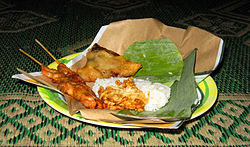- Nasi kucing
-
Nasi Kucing 
Nasi kucing with langgi and a side of chicken satay and martabakOrigin Place of origin Indonesia Region or state Yogyakarta, Surakarta, Semarang, Central Java Creator(s) Javanese cuisine Dish details Course served Main course Serving temperature Hot or room temperature Main ingredient(s) Rice in small portion with various side dishes wrapped inside banaan leaf Nasi kucing ([ˈnasi ˈkutʃɪŋ]; also known as sego kucing[1] and often translated cat rice[2] or cat's rice) is an Indonesian rice dish that originated from Yogyakarta, Semarang, and Surakarta but has since spread. It consists of a small portion of rice with toppings, usually sambal, dried fish, and tempeh, wrapped in banana leaves.
Contents
Etymology
The term nasi kucing, literally meaning "cat rice" or "cat's rice", is derived from the portion size. The portion of rice served is similar in size to what the Javanese would serve to a pet cat, hence the name.[3]
Origin
Nasi kucing originated in Yogyakarta, Semarang, and Surakarta.[4] However, it has since spread to Jakarta[1] and even as far as Mecca, sold by Indonesian workers during the hajj.[4]
Presentation
Nasi kucing consists of a small, fist-sized portion of rice along with toppings. Common toppings include sambal, dried fish, and tempeh.[3] Other ingredients can include egg, chicken, and cucumber.[4] It is served ready-made, wrapped in a banana leaf, which is further wrapped in paper.[3]
A variation of nasi kucing, sego macan (English: tiger's rice) is three times the size of a regular portion of nasi kucing. It is served with roasted rice, dried fish, and vegetables. Like nasi kucing, sego macan is served wrapped in a banana leaf and paper.[5]
Sales
 A seller at an angkringan, preparing tempeh with wrapped nasi kucing visible in the foreground
A seller at an angkringan, preparing tempeh with wrapped nasi kucing visible in the foreground
Nasi kucing is often sold at a low price (sometimes as low as Rp 1000 [US$ 0.12] for nasi kucing[6] and Rp 4000 [US$ 0.48] for sego macan[5]) at small, road-side food stalls called angkringan, which are frequented by lower class people, or wong cilik, including pedicab and taxi drivers, students, and street musicians.[7] This has led to angkringan being considered the "lowest class of eatery".[6]
The owners of the angkringan themselves often come from lower socio-economic classes, may have few or no marketable skills, or originate from remote villages.[8] In order to open their stalls, they borrow money from a patron, called a juragan; that amount can be up to Rp. 900,000.00 (US$ 105.00).[9] From the daily net profits of Rp. 15,000.00 – Rp. 20,000.00 (US$ 1.75 – 2.35),[10] the seller repays the patron until the debt is repaid and the seller is able to operate independently.[11]
See also
References
- ^ a b Erwin & Erwin 2008, p. 6
- ^ Mundayat 2005, p. 10
- ^ a b c Mundayat 2005, p. 83
- ^ a b c Hermanto; Purwadi, Trias; Jayadi, Fauzan (7 February 2007). "Nasi Kucing Juga Dikenal di Makkah [Cat's Rice is Also Found in Mecca]" (in Indonesian). Suara Merdeka. http://www.suaramerdeka.com/harian/0702/07/nas01.htm.
- ^ a b "Sega Macan Bakal Saingi Nasi Kucing [Tiger's Rice is Ready to Compete with Cat's Rice]" (in Indonesian). Kompas. 11 October 2010. http://nasional.kompas.com/read/2010/10/11/08555261/.
- ^ a b Yudhono, Jodi (16 April 2011). "Nasi Kucing, soal Rasa Berani Bersaing [Cat's Rice, the Taste is Ready to Compete]" (in Indonesian). Kompas. http://oase.kompas.com/read/2011/04/16/22084877/Nasi.Kucing.soal.Rasa.Berani.Bersaing.
- ^ Mundayat 2005, p. 73
- ^ Suprihatin 2002, p. 148
- ^ Suprihatin 2002, p. 158
- ^ Suprihatin 2002, p. 155
- ^ Suprihatin 2002, p. 163
Bibliography
- Erwin, Lily T.; Erwin, Abang (2008) (in Indonesian). Peta 100 Tempat Makan Makanan Khas Daerah di Jakarta, Bekasi, Depok, Tangerang [Map of 100 Eateries for Unique Local Foods in Jakarta, Bekasi, Depok, Tangerang]. Jakarta: Gramedia Pustaka Utama. http://books.google.ca/books?hl=en&lr=&id=LIrFeMpsX24C&oi=fnd&pg=PA2&dq=%22nasi+kucing%22&ots=nqeMaO-f2E&sig=ujl3O47ym2_aru45bF0k0zPH82k#v=onepage&q=%22nasi%20kucing%22&f=false.
- Mundayat, Aris Arif (2005). Ritual and Politics in New Order Indonesia: A Study of Discourse and Counter-Discourse in Indonesia (Doctorate thesis). Swinburne University of Technology. http://researchbank.swinburne.edu.au/vital/access/services/Download/swin:7520/SOURCE2. Retrieved 8 June 2011.
- Suprihatin, Sri Emy Yuli (April 2002). "Hubungan Patron Klien Pedagang "Nasi Kucing" di Kota Yogyakarta [Client-Patron Relationships of "Nasi Kucing" Sellers in the City of Yogyakarta]" (in Indonesian). Humaniora 7 (1): 147–164. http://eprints.uny.ac.id/317/1/HUBUNGAN_PATRON_KLIEN_PEDAGANG.pdf. Retrieved 8 July 2011.
Indonesian cuisine by ethnic group Common Indonesian dishes - Nasi goreng
- Nasi campur
- Nasi kuning
- Sate
- Soto
- Semur
- Tempeh
- Tahu goreng
- Gado-gado
- Sambal
- Acar
- Ketupat
- Lontong
- Bubur ayam
- Rujak
- Otak-otak
- Emping
- Krupuk
- Rijsttafel
Sasak - Ayam Taliwang
- Plecing kangkung
- Beberuk terong
Balinese - Betutu
- Lawar
- Babi guling
Javanese - Botok
- Buntil
- Gudeg
- Mie rebus
- Nasi bogana
- Nasi kucing
- Nasi liwet
- Nasi pecel
- Opor Ayam
- Pecel
- Rawon
- Sayur lodeh
- Serundeng
- Tumpeng
- Tongseng
Sundanese - Lalab
- Karedok
- Pepes
- Sayur Asem
- Oncom
- Soto Bandung
- Empal gentong
- Siomay
- Batagor
- Serabi
- Laksa
- Asinan Bogor
- Kupat tahu
- Tahu sumedang
Betawi - Nasi uduk
- Nasi ulam
- Nasi kebuli
- Ketoprak
- Soto Betawi
- Kerak telor
- Asinan Betawi
Minangkabau Sumatran Malay Batak - Saksang
- Arsik
- Babi panggang
Manado - Tinutuan
- Paniki
- Cakalang fufu
Makassar and Bugis - Coto Makassar
- Pallubasa
- Konro
- Sop sodara
- Kapurung
- Burasa
Maluku and Papuan - Papeda
- Sagu
- Babi bakar
Chinese Indonesian - Nasi Tim
- Bakmi
- Bakso
- Cap cai
- Fu yung hai
- Lumpia
- Mie goreng
- Mie Kering
- Swikee
Snacks - Pisang goreng
- Lupis
- Klepon
- Kolak
- Rempeyek
- Lapis legit
- Onde-onde
- Bika Ambon
Beverages See also: List of Indonesian dishesCategories:- Javanese cuisine
- Rice dishes
- Indonesian cuisine
Wikimedia Foundation. 2010.
